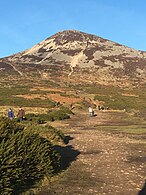Great Sugar Loaf
| Great Sugar Loaf | |
|---|---|
| Ó Cualann | |
Marilyn, Arderin | |
| Coordinates | 53°9′18″N 6°9′0″W / 53.15500°N 6.15000°W |
| Naming | |
| English translation | lump of Cualu |
| Language of name | Irish |
| Geography | |
| Location | Wicklow, Ireland |
| Parent range | Wicklow Mountains |
| OSI/OSNI grid | O2377613088 |
| Topo map | OSi Discovery 56 |
| Geology | |
| Mountain type | Quartzite bedrock[1] |
| Climbing | |
| Easiest route | Red Lane car-park |
Great Sugar Loaf (
Naming
According to Irish academic Paul Tempan, the term "sugarloaf" is widely applied in Britain and Ireland to hills of conical form, in much the same way that the name pain de sucre is used in France.[2] Tempan also notes that there is a widespread misconception that the term refers to a kind of bread, when it refers in fact to the stalagmite-like form in which sugar was sold up until the 19th-century, prior to the advent of granulated sugar. The traditional method for making a sugarloaf was complex, involving repeated purifications, moulding and a leaching process gradually to refine the mass of sugar, by ridding it of its associated molasses and eventually all trace of colour, leaving it a glistening white. This form of sugar is still used in the German alcoholic drink, Feuerzangenbowle.[2]
Tempan notes that a 1935 article by Eoin MacNeill in the Journal of the Royal Society of Antiquaries of Ireland (JRSAI), on placenames mentioned in the Togail Bruidne Dá Derga, suggested that Irish: Ó Cualann could refer to "sheep of Cualu", but considered it unlikely.[2]
Geography
The Great Sugar Loaf overlooks villages of Kilmacanogue and Delgany, and is just north of the Glen of the Downs. The mountain sits apart from the main nearby peaks of the Wicklow Mountains, such as Maulin 570 metres (1,870 ft) and Djouce 725 metres (2,379 ft), and it is circled by roads on all sides.[7]
The two small northern and southern shoulders of the Great Sugar Loaf are often confused as being the Little Sugar Loaf, however, this mountain lies to the east on the other side of the N11 road motorway at Kilmacanogue.[7]
Though only 501 metres (1,644 ft) in elevation, the Great Sugar Loaf's isolation from other hills gives it a large proportional
Geology
The Great Sugar Loaf is composed of Cambrian Period quartzite bedrock (called the Bray Head Formation), in contrast to the rounded Wicklow Mountains to the west, which are mostly made of Devonian Period granite. The Great Sugar Loaf is also popularly mistaken for a dormant volcano, however, it is instead an erosion-resistant metamorphosed sedimentary deposit from the deep sea.[6][9] Cambrian quartzite metamorphosed from sandstone at the bottom of deep oceans is extremely resistant to weathering.[6]
The Kilmacanogue valley, which the Great Sugar Loaf overlooks, was part of a regional north-south subglacial meltwater drainage route that included the Scalp (to the north) and the Glen of the Downs (to the southeast).[6]
Hill walking
The Great Sugar Loaf is popular with hill walkers given its proximity to Dublin, access from the N11 motorway, and relatively worn pathways that do not require full hiking boots or extensive navigation skills. In addition, the mountain also offers some mild scrambling up rocky gullies which adds to its appeal.[7]
The easiest route is from the south, starting from an established large car-park (O235119) situated off the middle of the Red Lane road (also known as the L1031 road) that runs along the southern boundary of the mountain; the car-park is already at an elevation of circa 290 metres (950 ft), and thus the total climbing elevation required is only 210 metres (690 ft). The 3.5-kilometre route from the car-park to the summit and back takes between 1–1.5 hours, and includes a walk over flat moorland paths and a final scrambling ascent through some rocky gullies.[7]
A longer route can be done from the east, starting from lower down at the Kilmacanogue GAA car-park (O233141); this 5-kilometre route from the car-park to the summit and back takes 2–2.5 hours, and is mostly on moorland paths with some scree and gravel sections.[7]
Bibliography
- Fairbairn, Helen (2014). Dublin & Wicklow: A Walking Guide. Collins Press. ISBN 978-1848892019.
- Fairbairn, Helen (2014). Ireland's Best Walks: A Walking Guide. Collins Press. ISBN 978-1848892118.
- ISBN 978-1-84889-164-7.
Gallery
-
From the west in Winter.
-
From the Red Lane car-park.
-
From Maulin.
-
View to Little Sugar Loaf.
-
From the Powerscourt Estate
See also
- Wicklow Way
- Wicklow Mountains
- Lists of mountains in Ireland
- List of mountains of the British Isles by height
- List of Marilyns in the British Isles
References
- ^ MountainViews Online Database. Retrieved 11 July 2019.
- ^ a b c d Paul Tempan (February 2012). "Irish Hill and Mountain Names" (PDF). MountainViews.ie.
- MountainViews Online Database.
- MountainViews Online Database.
- ISBN 978-1-84889-164-7
- ^ a b c d Sile Daly (May 2016). "The Great Sugar Loaf: Geological Context" (PDF). Irish Mountaineering Club. Retrieved 11 July 2019.
Popularly mistaken for a volcano, its metamorphism has rendered the rock extremely erosion-resistant and the mountain owes its shape to the weathering characteristics of quartzite.
- ^ ISBN 978-1848892118.
Route 57: Great Sugar Loaf
- Database of British and Irish Hills.
- Irish Times. Retrieved 11 July 2019.
The peak of the Great Sugar Loaf was never a volcano, but started life as sand on the ocean floor.
External links
- MountainViews: The Irish Mountain Website, Great Sugar Loaf
- MountainViews: Irish Online Mountain Database
- The Database of British and Irish Hills , the largest database of British Isles mountains ("DoBIH")
- Hill Bagging UK & Ireland, the searchable interface for the DoBIH










